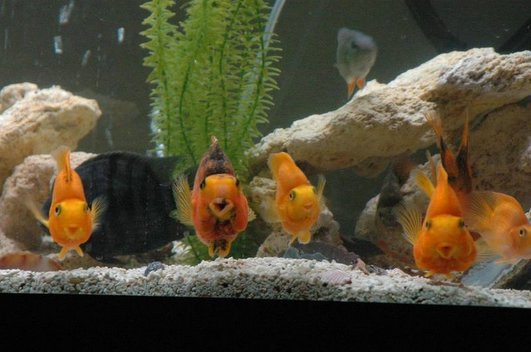| Data Sheet | 
| | Scientific Name: | None | | Family: | Cichlidae | | Origin: | Crossbred, not available naturally | | Adult Size: | 8 (20cm) | | Social: | Peaceful fish, but territorial | | Lifespan: | 10 years | | Tank Level: | All levels | 
| | Minimum Tank Size: | 20 gallons (young) -50 gallons (adult) | | Diet: |
Omnivore | | Breeding: | Egg Layer | | Care: | Easy-medium | | Ideal pH: | 6.5-7.0 | | Temperature: | 72-82 F (22 - 28 C) | Tank setup:
| Some rocks and places to hide is preferred | | Sexing: | Not Known. Sorry | |
|



| Description: The Blood Parrot is a brightly colored, odd shaped Cichlid. As its name suggests, the fish has a red body and a mouth that resembles a beak. These fish somewhat resemble fancy goldfish and appear to swim awkwardly due to their deformed swim bladders.
Habitat/Care: Blood Parrots like an aquarium with lots of rock formations and caves for retreating and hiding. Their habitat should be roomy and provide plenty of hiding places, so they can set up their own territory. Rocks, driftwood, and clay pots on their sides are good options. Like other cichlids they will dig in the gravel, so choose a substrate that is not too rough. Plants are not essential though they do not harm them. Mixing with other fishes:
The blood parrot is a cross-bred from cichlids parents, and you would expect these fish to be highly territorial and aggressive. However, these fish are surprisingly shy and peaceful - and many owners have successfully kept them in a community tank with other mid-size fish such as danios, angelfish, and catfishes. However, true to their parents' heritage, these fishes can be highly territorial and may fight with their tank mates if kept in a community tank. If these fishes are kept with other cichlids, care should be taken to ensure that their tank mates are not overly-aggressive. | Diet:
Since they are omnivorous, the Blood Parrot will generally eat all kinds of live, fresh, and flake foods. Flake food or pellets are recommended as these food usually contains a mixture of vegetables and meat. Brine shrimp (either live or frozen) or Blood worms can be given to them as a treat. When the parrots are bigger, they begin to prey on smaller fish, such as guppies, neon tetras etc. Breeding:The Blood Parrot, Bloody Parrot, or Blood Parrotfish have been known to breed but most often their eggs are infertile unless they are paired with a non-hybrid fish. I am unable to find out more about breeding blood parrots at the moment, but will endeavor to do so. |
Photo Galley
Got a photo? Contact me. Reader's Pet
Here is a contribution from a reader name Levah Lightfoot.
I've read many comments on this website about blood parrots. I've laughed with what was said about some of them and the things they do. Well here I am writing about our blood parrot, "Angelina", she is so much fun to watch and boy! does she have character plus!!! We have 9 grandchildren, when they come they go to see "Angelina", she seems to know them or at least she always comes to the front of the tank and watches them. She will follow their finger accross the front of the tank. If anyone is in the room she is always at the front of the tank looking at them. When we watch T.V. at night, her feeding time she won't stop looking at us until she gets her food. Now she is the leader of the tank, she lives with four Silver Dollars, two Ballah Sharks, one small catfish and a very large algea fish. When she eats she gets what she wants and they all get the rest, they chase each other for food BUT no one chases "Angelina". It's so much fun to watch her and she seems to like it when you put your hands or arm in the tank, she will rub your hand or arm as if to say, "Hello!". We have a large German Shephard, if you ask her , "where is Angelina?" she will run to the tank and look and "Angelina" will come to the front of the tank and look at the dog. Crazy yes!  Angelina in a Pot Angelina in a Pot | |  Angelina outside pot Angelina outside pot |  Angelina with Ballah Shark Angelina with Ballah Shark | |  Angelina with Silver Dollars Angelina with Silver Dollars |
References Cited:1. Shirile Sharpe, [Online], Available http://freshaquarium.about.com/cs/livebearers2/p/redtuxedo.htm
2. Shirile Sharpe, [Online], Available http://freshaquarium.about.com/cs/cichlids1/a/bloodparrot.htm
3. David Brough, [Online], Available http://animal-world.com/encyclo/fresh/cichlid/blparrot.php
4. Micheal McWin [Online], Available
http://www.aquariacentral.com/fishinfo/fresh/bparrot.shtml |











 Angelina with Silver Dollars
Angelina with Silver Dollars




















No comments:
Post a Comment